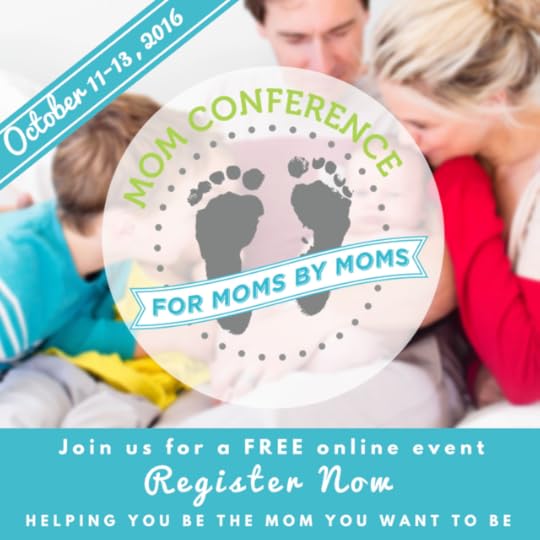Ruth Soukup's Blog, page 55
October 14, 2016
5 Ways to Set Stuff Limits for Your Kids

We are so so grateful to have kids who are loved by their relatives. I’m sure you are, too.
But…do birthday parties at your house look like a toy store exploded? Have you ever found your two-year-old so overwhelmed at Christmas, she only plays with one thing? Or perhaps she even prefers the boxes and bows to anything under the tree? Do you ever look around after these special occasions and sort of dread dealing with all this STUFF?
It’s no secret our lives are filled with stuff. Many of us are literally bursting at the seams of our houses with toys and accessories, clothes, Legos, Barbies, Littlest Pet Shops, and Star Wars everything. Kids’ rooms and closets become voids where it’s impossible to enjoy or even find the things they have.
On that now-infamous day when I took away my kids’ toys, I learned a very profound lesson–they didn’t really need all that stuff, or even really want it. While I expected them to freak out, it didn’t happen. Instead their creativity flourished and they began appreciating the things they do have even more. And while it has been several years now, we’ve never gone back to the “old” way. Our kids do have toys, yes, but only just a few.
As adults, we’ve grown accustomed to the mentality that we should always have “more,” score better deals, and save money by bringing in more stuff. But kids haven’t been tainted by the idea of “bigger, better, faster, more” yet, and they’re simply happy with what they have.
If you’re drowning in a sea of toys, here are some practical ways to set stuff limits for your kids:

Setting Limits with Relatives
As beautifully as my girls adapted to the new idea of having less “stuff,” our relatives and friends didn’t quite embrace it as fully.
My husband’s sister, who passed away a few years ago, had no children and loved our daughters like her own. She LOVED giving them gifts and spoiling them as much as possible. It was always well intentioned and came straight from the heart.
Unfortunately, it also led to the chaos of our already-stuffed-to-the-gills house. One Christmas in particular, she gave our girls so many gifts we hardly knew where to put them all. Many of the items ended up in the attic, and later, as we were organizing and decluttering, I packed them up to donate to charity.
I took a photo showing how many things we’d “cleaned out” and posted it here on the blog. My sister-in-law saw the post with the photo showing so many of her gifts in the pile, and was, understandably crushed. I apologized up and down but felt terrible, and still do, to be honest. It was such a cringe-inducing moment, and I know it hurt her feelings.
But looking back on it, I realize that the real misstep was in our hesitation to set strong limits with family beforehand. Yes, we said, in a half-joking voice, “We’re cleaning out. No more stuff this year!” But we knew full well that there would be gifts.
A better way to handle it (and what I’ve found works best today) is to be up front and honest about it. A sincere request and explanation can really help steer things in the right direction and prevent awkwardness and hurt feelings later on.
For family like grandparents, who tend to overdo it when it comes to gifts, explain you’re trying hard to set some limits. You’ve recently been cleaning out and getting organized and you want to help your kids embrace the idea of charity and appreciation for what they have. Explain that you’d really appreciate it if they’d help you with this parenting endeavor and support you.
If they say they just love to shop or they really find joy in picking out Christmas gifts, you can suggest they help you adopt a family in need. Have the kids help pick out gifts for a “Secret Santa,” while forgoing their own gifts or picking just one or two items that are really special.

Give Needs Over Wants
Another idea to help alleviate some of the excess during holidays and birthdays is to request assistance for a specific need. This might be seed money for a college fund, donations toward a school trip, or help with defraying the cost of uniforms and supplies for a sports team or hobby.
Ask family members to buy cleats, football pads, or hockey skates, or to help pay for lessons your child really wants to try. If your daughter has been begging to give ballet a whirl or try horseback riding, it would make a wonderful gift!
Asking for specific clothing also helps fulfill some needs. Perhaps your son needs a new winter coat or boots. Maybe new, cool shoes for school or an outfit for a dance or special event would be even more meaningful as a gift.
As parents, it can be hard to shift your mentality to asking for “needs,” especially if you don’t subscribe to the philosophy of “it takes a village” and you embrace self-reliance. However, allowing relatives to give something meaningful that can also help out with your financial constraints can be a real gift to the whole family, not just your child.

Request Experiences Rather than Gifts
Rather than giving items, ask insistent friends and relatives to give experiences, rather than gifts. It doesn’t have to be a cruise or Disney Vacation. It can be something simple—a day of cookie making with Grandma, a trip to a children’s museum, or going to a movie together.
These small moments can be the most meaningful and create memories your kids will cherish for a lifetime.
For a birthday party with friends, it’s perfectly gracious to write on the invitation, “No gifts please. Your presence is our only request.” Or, ask each friend, “Instead of a gift, bring your favorite stuffed animal to join in the party fun.” If you plan a trip to an amusement park, swimming pool or another activity where cost is a factor, most fellow parents will greatly appreciate not having to shell out for a gift in addition to the activity. In fact, you just may find them following your lead for their child’s next birthday party.

Gratitude Above All
When your child receives a gift (or several gifts), no matter what, always encourage graciousness. Teach your kids to always say thank you and follow the basic rules of gift etiquette from an early age.
This means opening the card first and reading it aloud. Express appreciation (never disappointment) and tell the gift-giver how much you appreciate the thought. While you, as a parent, may privately need to talk to a family member about overdoing it on gifts, your kids should always learn to accept things kindly and graciously, especially in front of an audience.
No matter what you end up doing with the gift, teach your kids how to write a well-thought-out thank you letter, telling the recipient not only how much they enjoyed the gift, but more importantly, how much they enjoy their relationship with the gift giver and the meaning behind the present.
Even at a young age, kids can learn to draw a picture and help mom compose a thank you note to go along with their present.

When to Decline
In most cases, it’s probably best to accept the gift, say thank you and move on, even if you’re frustrated with a relative who keeps giving gifts against your requests or preferences. It’s much easier to try to stave off over-giving on the front end then to put the toothpaste back in the tube once the gift has been given.
That said, there are a few things you can do when you’re given a gift you don’t feel comfortable accepting. Above all, always say thank you right away. Thank the giver for their thoughtfulness, kindness and sentiment.
Let them know the gift is far too valuable and you’re not comfortable accepting it. If the gift is something that doesn’t match your parenting philosophy or something you don’t approve of, simply let them know you appreciate it greatly, but you know they didn’t realize you don’t allow the item in your house, so you’ll have to decline.
In most cases, however, it may be easier to simply accept the gift and further down the line, just let the giver know you’ve been cleaning out and decluttering your home. Explain how you’re trying to embrace a new philosophy on fighting the flow of stuff, and while they were so generous at the last birthday/holiday/etc. next time, would they be willing to skip gifts? In all cases, this is a conversation for the adults. Kids should learn to just accept the gift graciously.
Fighting the flow of stuff means working hard to keep new things from coming into our homes and cluttering up our lives. When we’re blessed to have people in our lives who love us and our kids, and who want to show that by giving gifts, it can be hard to stop it. You might feel like a killjoy or “fun ruiner” by keeping gift giving at bay.
However, when it comes down to it, it’s really about the relationships and not about the stuff. It’s about cultivating our friendships, expressing our gratitude, and holding our loved ones close. It’s about letting them know we appreciate their expression of love and tokens of affection, but what we really want is their time and connection. Sharing this love and mindset can help us change up the pattern and perhaps even someday get unstuffed.

Pin It
The post 5 Ways to Set Stuff Limits for Your Kids appeared first on Living Well Spending Less®.
October 12, 2016
Easy Pumpkin Bread

This is a guest post from Sammi of Grounded & Surrounded
I love to bake family recipes. There is something special about pulling out an old tattered recipe card or discolored piece of paper and reading the tender hand writing. Every year as the weather cools and the leaves begin to turn, I page through my recipe binder to find this tested and true list of ingredients.
Passed down from my grandmother, there is no other recipe my mother made more when I was a kid than this fall bread. She loved baking it for not only us, but our neighbors. I am so thankful to learn from her generous heart because each year my own neighbors are now the happy recipients of this recipe!
The ingredients combine to bless at least 7 people with cute little loaves or you may choose to bake 2 larger loaves to slice up and enjoy for breakfast that week. This base recipe is also incredible with the addition of chocolate chips, dried cranberries, or a crumb topping (see recipe note at bottom of post).
I encourage you to bake this sweet bread with your family each year. The memories of baking this bread with my mom are so precious to me. Plus, the simplicity of this recipe lends well to little hands helping or even big hands for that matter. Before you know it, this recipe will become a part of your family traditions too!

Here is what you need:
3 1/3 cups flour
2 cups sugar
2 tsp ground cinnamon
1 tsp ground nutmeg
2 tsp baking soda
1 tsp salt
15 oz can or 2 cups pumpkin puree (not pumpkin pie filling)
4 eggs
1 cup oil
2/3 cup water

Step 1: Preheat oven to 350F. Generously grease 7- small (6″x3″) loaf pans or 2 large (9″x6″) loaf pans with nonstick cooking spray.
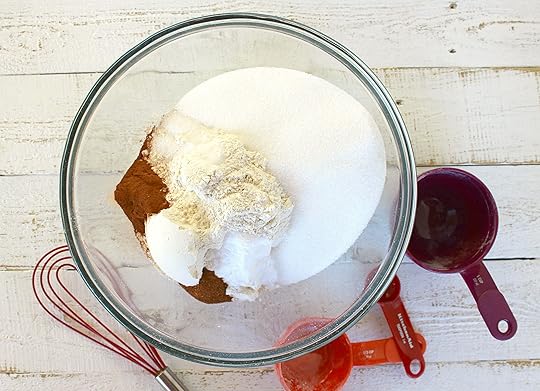
Step 2: In a large bowl, combine the dry ingredients – flour, sugar, cinnamon, nutmeg, baking soda, and salt. Set aside.

Step 3: In a medium sized bowl, add all the wet ingredients- pumpkin, eggs, oil, and water. Whisk together until combined.

Step 4: Pour wet ingredients into the dry ingredients and gently mix until all ingredients are combined into a smooth batter.

Step 5: Pour batter into greased pans. Bake smaller loaves for 40 minutes and larger loaves for about 1 hour or until toothpick inserted comes out clean. Allow the loaves to cool on a wire rack before removing from the pans and storing or freezing. I wrap the cooled loaves in saran wrap and place in a Ziploc bag to store in the fridge or freezer.

Recipe Notes: My mom lines the bottom of her loaf pans with parchment paper after she greases the pan, but I have never had a problem with the baked bread sticking to the bottom. Another pan variation is to bake 1 large loaf and two smaller ones using this recipe. Feel free to also use whatever oil you prefer, I use coconut. Also here is the recipe for the crumb topping if you would like to give it a try:
1/2 cup brown sugar
1/2 cup flour
1 tsp cinnamon
1/4 tsp nutmeg
4 Tbsp butter, cold and cut into pieces
In a small bowl add all ingredients. Using a pastry cutter, back of a fork, or your hands mix all ingredients together until a crumbly mixture forms. Evenly distribute over each pan of batter.
Print This!
Recipe: Easy Pumpkin Bread
Summary: This simple Pumpkin Bread is a treasured family recipe that makes an appearance when the leaves start falling each year. It is the perfect bread to share with your neighbors or freeze to enjoy in the months to come.
Ingredients
3 1/3 cups flour
2 cups sugar
2 tsp ground cinnamon
1 tsp ground nutmeg
2 tsp baking soda
1 tsp salt
15 oz can or 2 cups pumpkin puree (not pumpkin pie filling)
4 eggs
1 cup oil
2/3 cup water
1 tsp salt
Instructions
Preheat oven to 350F. Generously grease 7- small (6″x3″) loaf pans or 2 large (9″x6″) loaf pans with nonstick cooking spray.
In a large bowl, combine the dry ingredients – flour, sugar, cinnamon, nutmeg, baking soda, and salt. Set aside.
In a medium sized bowl, add all the wet ingredients- pumpkin, eggs, oil, and water. Whisk together until combined.
Pour wet ingredients into the dry ingredients and gently mix until all ingredients are combined into a smooth batter.
Pour batter into greased pans. Bake smaller loaves for 40 minutes and larger loaves for about 1 hour or until toothpick inserted comes out clean. Allow the loaves to cool on a wire rack before removing from the pans and storing or freezing. I wrap the cooled loaves in saran wrap and place in a Ziploc bag to store in the fridge or freezer.
Preparation time: 5-7 minutes
Cooking time: 40-60 minutes depending on pan size.
Number of servings (yield): 20
Sammi Ricke likes to keep things simple, delicious, and nutritious in her kitchen.
She enjoys the challenge of finding unique ways to incorporate “just one more whole food” into every meal while leaving just enough room for life’s essentials: chocolate and peanut butter. If you are looking for “healthified” versions of your family’s favorite meals be sure to visit Sammi’s Grounded & Surrounded Blog. You can also find her on Pinterest, Instagram, and Facebook.

Pin It
The post Easy Pumpkin Bread appeared first on Living Well Spending Less®.
October 10, 2016
The Surprising Gifts of Pain

This is a guest post from author Melinda Means
It was nearly more than I could take.
After 20 years of battling chronic illness, I have a high pain tolerance. But last year at this time, I was smack dab in the middle of an excruciating stretch of agony that had me begging God for mercy.
He was silent.
Again and again, I came to Him with my frustrated, teary rants.
He seemed deaf to my desperate cries. Uninterested in my suffering.
I felt abandoned. He didn’t see me. I wasn’t His favorite. If I were, He would heal me. At the very least, He would relieve my intense present misery.
God had used my illness to make me stronger and more compassionate. But in the depth of my despair, I saw such uselessness in my suffering. Over and over again, I asked Him, “How can being debilitated possibly be Your will for my life? How can You possibly use this for my good?” Frankly, I didn’t care. I just wanted relief.
Although I didn’t realize it, my true need went much deeper than physical healing. I needed healing of my doubts about His love and goodness. I needed Him to break my stubborn self-sufficiency.
Around this time, I started going to a new doctor. As we sat down to discuss my test results, he said this: “Based on these results, I would expect you to come into my office in a wheelchair. I have no idea how you are functioning as well as you are.”
When I shared this with a sweet, wise friend she said something that became the turning point in my dark struggle: “Melinda, don’t you see? Look at all you have been able to do—be a wife and a mother, write a book, do ministry. You should be in a wheelchair! That is the grace of God in your life and in your journey. I don’t understand all the reasons why you are going through this awful stretch, but I know this: This period of your life is anointed.”
Gradually, God gave me eyes to see how He had been working in my journey. To recognize the gifts that He had been giving me all along the way.
A few weeks after that pivotal moment, I shared my story at my church publicly for the first time. Women came streaming to the altar, tears flowing. Burdens were being lifted; women were being set free from despair and isolation right before my eyes. I’ve never personally witnessed and experienced anything so powerful before or since.
And without my pain I would have missed it. It was the first time I was able to say with complete and genuine conviction: “Thank you, God, for my pain. It was all worth it.”
Do I stay in that place all the time? Sadly, no. But then God patiently reminds me of the gifts that my suffering has given me. Whatever your wound, whatever path of pain you are walking, God is giving you some unexpected presents along your broken journey.
Here are a few of the surprising gifts of suffering:

It breaks our self-sufficiency.
While my mouth said I trusted God, my actions reflected a different truth. I lived as if all results were up to me: If only I do all the right things, I’ll have perfect, rule-following children. If only I eat the right foods, discover the right treatment, I’ll have my health again.
My fiercely independent kids didn’t get the “be perfect” memo. My body missed my “get healthy” mandate. My inability to achieve the outcomes I wanted—the ones I needed to feel important and competent—made me feel profoundly weak and inadequate. Last fall, I came to the end of my physical and emotional resources. I could no longer bear the crushing weight of all outcomes resting on my shoulders.
As I lay in my bed during that time, unable to do anything, God internalized this truth in my heart with stunning clarity: “You can trust the One who died for you.” The little girl who said a prayer to accept Jesus into her heart at four years old, finally “got” it. I might not always understand His ways but I can trust He is good. The Cross settled that once and for all.
Slowly, I began to trust Him with each day, each moment, each outcome with a whole new sense of dependency. He is my only hope. As I face pain-filled days, I no longer look for an answer. I simply search for a Savior who can give me what I need. Step by step, I depend on Him with prayers like, “God help me through this moment. Show me how to find joy. Give me the power to trust You.”
Outcomes are not my job. Obedience is my job. Just following His leading. This simple, but profound truth has changed my life.

It leads us to our purpose.
Again and again, I’ve asked God, “Why would you give me a ministry and such passion for it and then allow me to be handicapped at every turn?”
I imagine that’s how Joseph in the Bible must have felt. God gave him big dreams as a young man. Then his brothers sold him into slavery. He was unjustly imprisoned and spent long, dark, lonely years there. He must have wondered if those long-ago dreams would ever be fulfilled.
But God was at work all along. During his years of suffering, God was working out virtues of faith, perseverance and humility in Joseph.
When the time was right, he drew on all the qualities suffering birthed in him and was put in a position to save a nation: “You intended to harm me, but God intended it all for good. He brought me to this position so I could save the lives of many people.” (Gen. 50:20)
As I walked off the stage that day last fall, I felt as if God said to me, “Pain hasn’t held you back from ministry. Encouraging those in pain is your ministry. Now go walk in it.”

It makes us more grateful.
It’s taken many years, but God has gradually opened my eyes to the little blessings right there in the midst of my pain. The things that I can easily take for granted.
Instead of thinking, I hate putting away groceries. I think, I am blessed to be able to have the physical ability to bring them in and put them away. I’m grateful for a pain-free day to enjoy my family. I praise God for even the smallest victories in my health and parenting.
I used to think, I’ll find joy when my circumstances improve. God wants our joy to be dependent on Him. All we have is this moment. Let’s look for the blessing in it.

It reveals our foundation.
In Matthew 5-7, Jesus gives a challenging discourse on the qualities that Christ followers should exhibit.
He finishes with this passage:
“Anyone who listens to my teaching and follows it is wise, like a person who builds a house on solid rock. Though … the winds beat against that house, it won’t collapse because it is built on bedrock.”
“But anyone who hears my teaching and doesn’t obey it is foolish, like a person who builds a house on sand. When the rains and floods come … it will collapse with a mighty crash.”
Suffering exposes the lies we believe. Building our foundation on our finances, our performance, our reputation, our faulty views of God, is setting us up for collapse when the winds come.
Everything that is not truth is sand. Everything that is not Jesus is sand.
Suffering reveals the sand. What God reveals, He wants to heal. If we allow Him, He will replace the lies with truth. He will build underneath us a stronger foundation.

It magnifies God’s sweetness.
Isaiah 30:18 tells us, “… the Lord longs to be gracious to you.” In our brokenness, I believe we are often the most attuned and open to His kindness. We appreciate it in a whole new way—because we need Him so desperately. We are desperate for His voice of reassurance.
The barrier in my heart over all these years—my internal, hidden doubt that I really served a good God—prevented me from fully experiencing and recognizing His gentle sweetness. I wanted the “big” healing. He wanted to speak sweetly to me in His still, small voice.
I hear it in the woman who says to me, “As I was praying for you, God told me He wants you to know it’s going to be okay.” I sense it in the stranger who says, “I only know your name, but God has been impressing upon me to pray for you.”
The gift of a “new thing”
Isaiah 43:19 tells us, “See, I am doing a new thing! Now it springs up; do you not perceive it? I am making a way in the wilderness and streams in the wasteland.”
For years, I thought the “new thing” was a change in the external. I wanted God to heal me. He wanted to give me so much more. He wanted to change me from the inside.
That “new thing”— this new perception that I have of God—has enabled me to receive His love and see myself as He sees me. It enables us to withstand our circumstances whatever they are.
Ask God to open your eyes to the gifts in your pain. He’s waiting to surprise you.
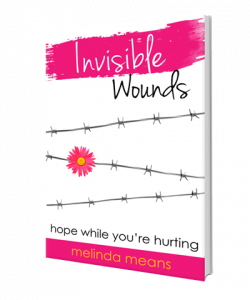
I share more encouragement and inspiration in my new book, Invisible Wounds: Hope While You’re Hurting. You’ll find my Invisible Wounds free Survival Kit, including printables and a Prayer Journal, on my website.
Melinda is a weary soul in need of refreshment
from the only Source who can quench our thirst. Melinda is a speaker, writing coach and author of two books. She points hurting women to the Healer on her blog melindameans.com.

Pin It
The post The Surprising Gifts of Pain appeared first on Living Well Spending Less®.
October 7, 2016
How to Set Better Boundaries with Your Friends

Few things in life are more painful than when a friendship drifts away and we’re left unsure what happened or why. Of course, sometimes we’re the ones who outgrow the friendship and sometimes it’s the other way around. The reality is that we don’t always perceive our relationships the same way. You may feel very close to a friend, but they might consider you just an acquaintance. Friendships are tricky waters to navigate and we aren’t always on the same page at the same points in our lives.
Look back to your high school and college days. Remember the friends you partied and hung out with? Whether or not they were great influences, chances are you felt very close to them. You probably spent a great deal of time with them and shared your deepest secrets. They may know things about you that you haven’t even shared with your spouse. You bonded with them deeply and, at the time, would have done anything to keep them happy and your relationship strong.
But after ten or twenty years go by, those friendships no longer feel as relevant or vital to us. We may still keep in touch, maybe through social media or the occasional phone call, but often we simply drift apart. Your spouse, your kids and your family take priority.
Today, you may spend more time with your fellow moms and neighbors. Your social circle probably consists of people who share an office with you, go to your church, and have similar family structures. Your best friends come from your kid’s playgroup, your fellow PTO members, or your neighborhood Meetup group. Since your college days, maybe you’ve moved to a different city, started to attend a different church, or pursued a different career path. Your values and interests have changed.
Our lives are a work in progress, so we’re always changing. While there are certainly some universal qualities of a best friend, lifelong best friends are probably the exception, not the rule. Yes, it’s important to our key relationships strong when we can. But for most friendships, the rule holds true as we get older: things simply change.
Sometimes change happens slowly and we’re not really sure why. Sometimes it happens because of a falling out—a friend lets us down, we have a fight, or an off-handed comment goes awry. We say something we regret or they say something hurtful. Sometimes friendships feel like they drag us down and make us feel irritated, belittled, drained or frustrated.
And when that happens, it might be time to set some better boundaries in your friendships.

Emotionally Draining Friendships
Sometimes our friendships can become draining and drag us down. You know the drill. We’ve all had a friend who’s more of a drain than a support. Either they constantly need favors, which they never return (Babysitting? A ride? Help with house projects?), or they need constant emotional attention and the conversation is always one-sided. (When did she even ask how MY day was going?)
While it’s important to be there for friends when they’re struggling or going through a hard time, we’ve all been faced with those friends who ALWAYS seem to need as much as we can give and then some. True friendship is about reciprocity and give and take. It’s about doing things for each other and listening to each other. Sometimes you might find someone who talks at you, rather than to you.
Part of dealing with a one-sided friendship is to establish proper boundaries. We have to give ourselves permission to say no and learn to decline gracefully. We have to learn it’s okay to be there for a friend sometimes, but we don’t have to be there all the time or at our own expense.
These lessons can be challenging. Everyone is fighting a hard battle and if a friend is going through a particularly rough time—a death in the family or a divorce—of course we want to do everything we can to be there for them as much as possible.
You’ll know if a friend is simply going through a tough time right now and needs some extra support and patience, or if the tough time is constant. If your relationship is taking away from your time with your spouse or children, becoming emotionally draining, or making you depressed, anxious or overwhelmed, it may be time to step back.
For some, this might mean establishing a time limit on your check-ins or a regularly scheduled time when you can touch base. Offer a narrow window to prevent the conversation from spiraling endlessly. Let your friend know you’ll call them Wednesdays on your way to work (which keeps conversations limited to a set timeframe) or meet with them for a bi-weekly coffee where you can lend an ear over your lunchbreak. When they call you up outside of your set “session,” let them know you’re looking forward to lending your ear the next time you see them, but for now, you’ve got something else going on.
Give your friend time. If they need to talk through their feelings about their ex or loved one, listen and support them. If it sounds like a broken record or you suspect they need more than you’re able to give, it may be time to encourage them to talk to a professional.

Competitive Friendships
When you have a friend who’s inspiring and naturally good at things, they can be just the thing you need to spur you on and help you strive to be even better. After all, a great friend can motivate us to get in better shape, get ourselves organized, or embrace healthy habits like gardening and other hobbies. Our friends can enlighten us spiritually and bring us joy. We all want friends we can look up to.
However, some friends become too competitive, leaving us feeling belittled, put down or bad about ourselves when we hang out with them. Maybe they interrupt or correct things you say. Maybe they’re critical of your kids, your spouse, or your looks.
Understand when a friend is being critical of you, it may stem from a place of jealousy or insecurity. Why else would someone feel the need to tear you down? If they’re comparing themselves to you all the time or one-upping the things you say (“Oh, your daughter has a dance recital? Well our daughter is thinking of trying out for Julliard”), chances are, it’s because they want you to think they’re important or special.
Or there’s the friend who offers unsolicited advice (aka criticism). Maybe they helpfully suggest you lose weight, your hair looks better a different way, or your kids should behave in a certain manner. It’s one thing if you’ve asked, “How does this look on me?” and someone gently tells you to go with a different option. It’s quite another when you get to work and your coworker says, “Wow, that sweater looks really bad on you.” Somehow you “doing you” makes these unsolicited advisors feel uncomfortable and they want to “fix you” or tell you what to do.
If you have a friend who’s critical or competitive, you can either try to confront them and discuss it or simply distance yourself from them. If you feel it’s something building over time or it’s not in their normal nature, maybe it’s time to address the issue candidly. Let them know you’ve been feeling a strange vibe because they seem a little competitive or critical lately and you’re wondering if something’s bothering them or what you can do to work things out, because it’s making you feel bad.
In most cases, this direct approach will be enough to help your friend do a reality check. It may clear the air and redirect their approach. Maybe there’s something bothering them and they’re waiting for a chance to get it out, too.
On the other hand, some people are just critical. When you realize you’ve befriend a critic, you may want to reevaluate your situation. Are there positives of your friendship you’d like to hold on to? Are you willing to let their comments roll off your back and let it go?
If the answer is no, then it might be time to say goodbye to this critical friend. Put some healthy distance between you and your “buddy” and remind yourself their words come from an insecure place and shouldn’t be taken personally. Unfortunately, people aren’t always open to change and sometimes you may just be better off walking away.

Friends with Different Values and Priorities
Many friends show up at different times in our lives. Those college friends were probably great to hang out with at the bar, but as a mom of a five-year-old, your bar days might be well behind you. Maybe your friend hasn’t moved on yet.
Just because you’re in a different place in life doesn’t mean you can’t be friends. If your friend is still in the singles scene, but you have kids and you’re trying to save money and they want to go out, or you just bought a house and moved to the suburbs and your friend is a city girl through and through, you might feel like you have less and less in common and have drifted apart.
In some cases, this might be true, especially if you were simply casual acquaintances or friends because you worked in the same office or hung out in the same social circles. For true friends, though, it’s usually worth looking past the different life stages and remembering what your commonalities were that made you so close.
Take a pen and paper and write down all the things you appreciate about your friend. Does she make you laugh? Does she have great fashion advice? Is she a wonderful listener or someone you feel really keeps up with you intellectually? Focus on these qualities and ask yourself if it’s worth the extra effort, distance and time to keep your friendship strong.
You might look at the list and go, “Heck yeah it is!” In this case, call her, send her a little text message, or write her a note and let her know you’re thinking about her and miss her.
Or, you might look at the list and think, “Eh, we had some good times, but I just don’t miss the relationship that much.” In this case, it’s perfectly fine to let the friendship drift into the social media zone. Keep in contact occasionally and send a card, a note, or a message now and again, but it’s okay to move on. This is especially true if you feel your friend’s priorities might be damaging to you, or if you’re trying to move away from past behavior this friend encourages.
You don’t have to share the same views as your friends on everything. (How boring would it be if you were exactly alike?) Friends that make you think differently, stretch you to examine yourself and your worldview, and push you to be a better-rounded person are vital! However, friends who drag you back to places you’ve moved on from or who bring out negative aspects of your personality might be best kept at a distance. Sometimes it’s time to move on.
Friends are so important. They bring us joy. They’re there for us and they make us better people. Keep your friendships strong by knowing which friendships are worth pouring extra time and energy into and which are better left as Facebook contacts.

Pin It
The post How to Set Better Boundaries with Your Friends appeared first on Living Well Spending Less®.
October 5, 2016
One Pot Pasta and Clam Sauce
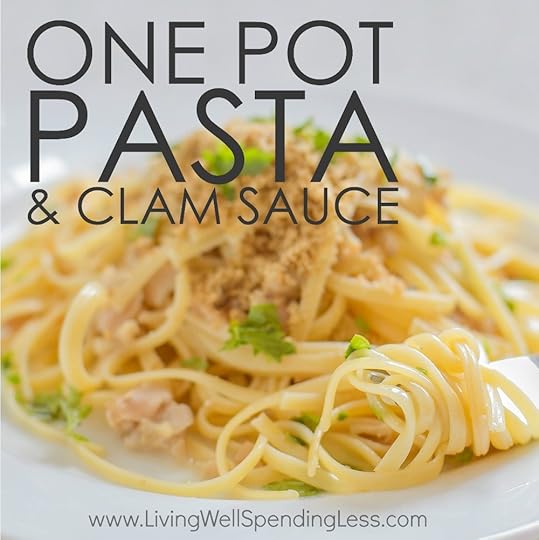
I’ll be the first to admit that I’m not really a foodie. Don’t get me wrong, I love food, and I don’t mind cooking, but most of the time, in the midst of a busy day/week/month/year, I just want food that tastes good, whips up fast, doesn’t use a ton of dishes and does use the pantry staples I already have on hand.
This simple one pot pasta and clam sauce definitely fits the bill! With just a few ingredients that might just be in your pantry. It’s even “fancy” enough to serve to guests.
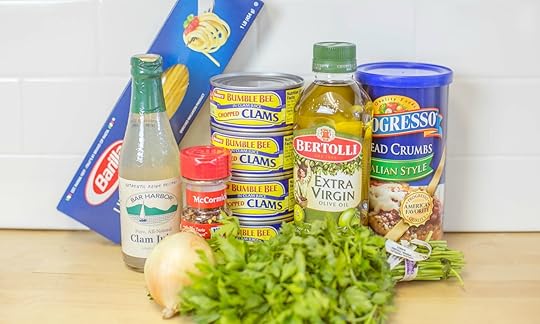
Here is what you need:
4 6.5oz. chopped clams
1 bottle clam juice
1 lb. linguini
1 bunch parsley
1/2 of one small yellow onion, diced
4-6 tablespoons olive oil
1/2 teaspoon crushed red pepper flakes
1 cup seasoned breadcrumb

Step 1: Heat a 2 tablespoons of olive oil in a small pan and lightly brown breadcrumb. Then set aside.
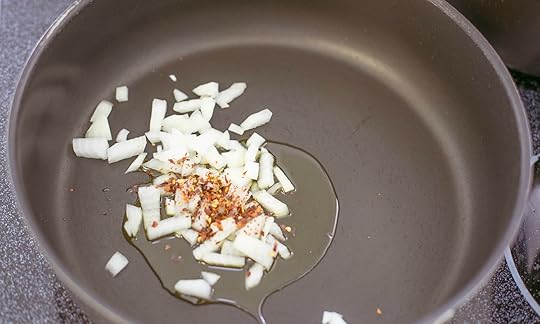
Step 2: Dice onion, then set aside. In a large saucepan heat 2 tablespoons of oil and then add onion, crushed red pepper and saute.

Step 3: Then add the four cans of clams and the bottle of clam juice to the large pan. Let simmer on medium heat for 5-10 minutes.

Step 4: Then add pasta, cover with clam juice and add 2 cups water, lower heat and cover with lid. Cook pasta until al dente.

Step 5: Serve in bowls and top with bread crumb and fresh chopped parsley.
Print This!
Recipe: One Pot Pasta and Clam Sauce
Summary: This one pot pasta dish is sure to be a new family favorite!
Ingredients
4 6.5oz. chopped clams
1 bottle clam juice
1 lb. linguini
1 bunch parsley
1/2 of one small yellow onion
4-6 tablespoons olive oil
1/2 teaspoon crushed red pepper flakes
1 cup seasoned breadcrumb
Instructions
Heat a small amount of oil in a small pan and lightly brown breadcrumb. Then set aside.
Dice onion, then set aside. In a large saucepan heat 2 tablespoons of oil and then add onion, crushed red pepper and saute.
Then add the four cans of clams and the bottle of clam juice to the large pan. Let simmer on medium heat for 5-10 minutes.
Then add pasta, cover with clam juice and add 2 cups water, lower heat and cover with lid. Cook pasta until al dente.
Serve in bowls and top with bread crumb and fresh chopped parsley.
Preparation time: 5-7 minutes
Cooking time: 8-12 minute(s)
Number of servings (yield): 4-6
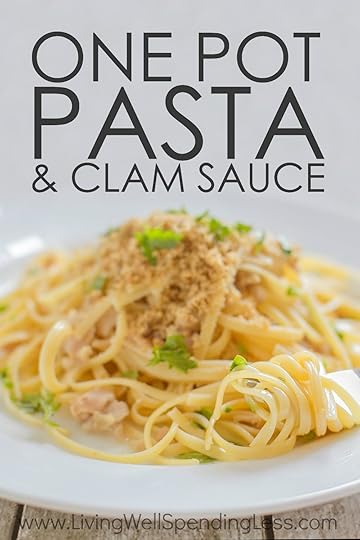
The post One Pot Pasta and Clam Sauce appeared first on Living Well Spending Less®.
October 4, 2016
Calling All Moms!
Let’s face it—being a mom can be pretty tough sometimes. We all started out with this perfect picture of how we thought motherhood would be, but we soon learned, that when it comes to kids, very little goes the way we expect it to!
In the ten plus years that I’ve been a mom, I’ve learned that nothing helps soften those bumps along the way like commiserating with other moms, sharing encouragement and support (and even a little wine at times!) There’s nothing better than a day or a weekend—or even a few hours—spent connecting with other women who know exactly what you are going through.
But I also know that the reality of being a mom is that there’s not always a lot of time to make those connections, even when we desperately need the support, and that is why I would like to invite you to join me next week at the Mom Conference. (Don’t worry—it’s free!)
It’s a once-a-year, 3-day online event featuring a number of amazing speakers (including me!) We’ll be sharing tips on all sorts of topics related to motherhood—how to understand your kids’ crazy moods, how to manage screen time, how to raise grateful kids, how to develop and stick to a budget, how to clean your house in less time and finally get organized, how to nurture your marriage when you are short on time, and so much more!
The event is 100% online and free to join, but you do have to register to get access. Each day you’ll get an email with the day’s presentations, and you’ll have 24 hours to watch them, which lets you pick and choose the ones that interest you, and to watch on your own schedule!
Pin It
The post Calling All Moms! appeared first on Living Well Spending Less®.
October 3, 2016
It’s Back! Get the 2016 LWSL Holiday Planner
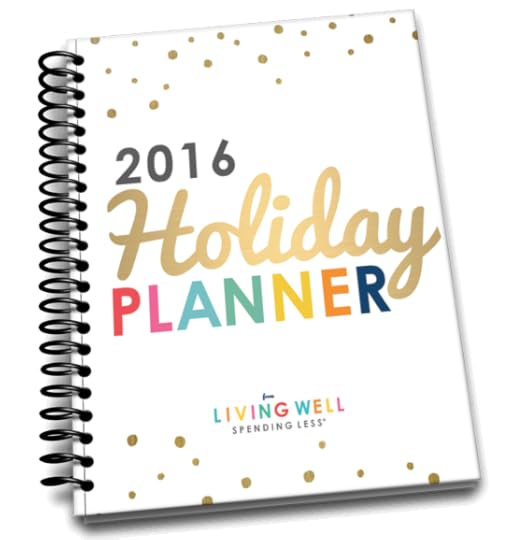
GET MY HOLIDAY PLANNER!
It’s a little hard to believe, but the holiday season is right around the corner and will be here faster than you can say Trick or Treat. So the big question is this—are you ready?
If you are anything like me, this is about the time where you swear to yourself that THIS year will be different. This will be the Christmas you’re finally organized, the Thanksgiving where you don’t have to make fourteen trips to the grocery store, including one right before the store is closing on Wednesday night. This will be the year you stop running around like a crazy person and instead enjoy cozy nights at home in front of the tree. This will be the year of less stress and more joy.
And then November happens and things start to get hectic, and before you know it December is here and the real craziness starts, and by the time January begins,both you and your budget are overspent.
Sound familiar?
Believe me, I get it! You see, I used to feel exactly the same way! Until finally one day in 2011, I’d had enough. I decided something had to give and so, to help myself get control of the situation, I created my first-ever Living Well Spending Less Holiday Planner™ and shared it with the LWSL Community. It was such an instant hit that we have been creating one every year since!
We usually start giving it away November 1st, but we always get a TON of requests to make it available even earlier, so this year we pushed ourselves to get it done a little earlier, so that you could get it in your hands even sooner. After all, early planning is a key ingredient to having less stress for the holidays! With that said, we are happy to announce that the 2016 Living Well Spending Less Holiday Planner is now available and ready to download!
Our free Living Well Spending Less Holiday Planner™ is intended to help you (and myself) create more joy and less stress around the holidays. It will help you prioritize your time, set a budget, plan your meals, create a gift list, and make the most of your holiday season. Each year we also take your feedback & suggestions, which means it just keeps getting better.
In fact, this year’ s version includes shopping plans for Black Friday and Cyber Monday, multiple grocery lists for your different occasions, and even a party planning worksheet.
In other words, it is a total lifesaver–one that might just make all the difference for your sanity this year!
And the best part?
It’s completely FREE-just our way of saying thanks for being part of the Living Well Spending Less® community! Simply click the button below to have our 2016 Holiday Planner sent straight to your inbox.
GET MY HOLIDAY PLANNER!
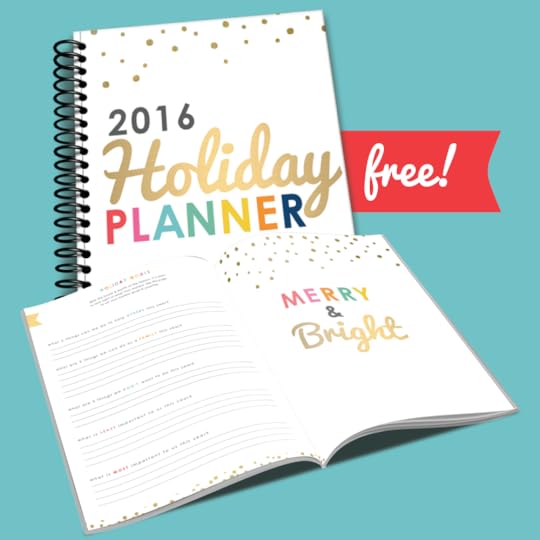
Pin It
The post It’s Back! Get the 2016 LWSL Holiday Planner appeared first on Living Well Spending Less®.
September 30, 2016
5 Facts You Need to Know About the New Chip Cards
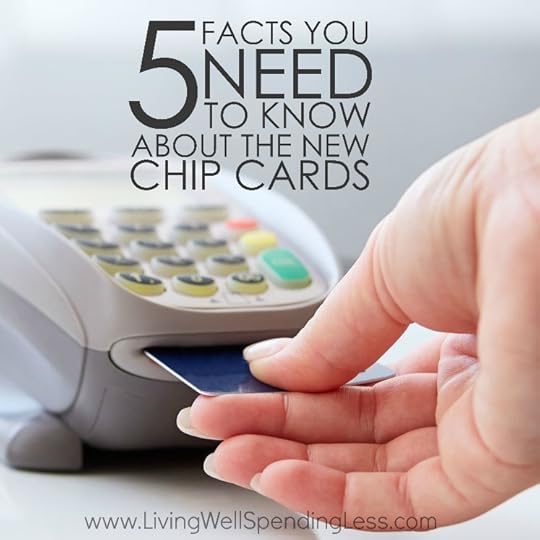
This is a Guest Post from Cherie at Queen of Free
The next time you need a little icebreaker or party game, try this on for size. Ask your friends, family, or dinner party guests what they’ve bought without their knowledge. I’m not talking about online sleep shopping or the items that toddlers sneak into carts. I’m talking about what they’ve purchased due to having a credit card hacked.
My friend Bob laid down plastic for thousands of dollars of Mary Kay makeup in England. My friend Tricia bought a big screen TV. My college buddy Becky attempted to win big in Vegas, betting over a grand at a casino. And me? Due to my propensity for online gaming I purchased $450 worth of World of Warcraft role-playing goodies. I tried to purchase another $450 but my card shut down.
Of course, none of us actually bought any of these things! And all of us carry a significant grudge for the thieves who hacked our accounts, dispersing worry, hassle, and feelings of violation along with their spurious purchases.
Shopping with plastic brings with it risk. Each time you make a purchase online, swipe, or now insert your card into a payment kiosk, you could be hacked. In recent years, major breaches invade even the most notable retailers leaving consumers to clean up the mess. Accounts are closed and new cards need to be issued. You may even have a day or two without access to your own money.
It’s for this very reason, many banks and credit card companies recently rolled out the EMV chips on their cards. If you haven’t been issued one yet more than likely yours will arrive before the end of 2016.
But a simple switch has confused consumers like me, you may be perplexed every time you check out. Do I swipe? Do I insert? Do I hit the green button? Do I have to use my PIN? Do I still have the credit card company’s protection if the purchase is processed as debit? Currently, it seems like every retailer has a different procedure. Here’s everything you need to to know about EMVs.

What Does EMV Even Stand For?
I’m going to give you personal finance gold star stickers if you already knew the meaning of the EMV abbreviation. I had been using the term for a few weeks before I realized that it stood for Europay Mastercard Visa. The chip style of card has existed in Europe for nearly two decades.
Why EMV?
So what’s the purpose of a chip style card? Traditional cards transmit data via a magnetic stripe on the back of your card that you swipe through a card reader. All of the data for that card is shared via a single transaction. Chip cards create a unique code for every single use, instead of sharing all of your data with a retailer who then could be hacked like Target was back in 2013. Data stolen from magnetic stripe cards can be easily replicated, allowing thieves to hijack your card and use it for their evil purchases of makeup or TVs or online gaming. But since EMVs create a different data set for every purchase, a layer of protection is added to your account. The goal of chip reader technology is to reduce fraud and safeguard consumers. While no cards or systems are 100% foolproof, the EMV transactions have already dropped fraud rates by over 30%. That’s good news for those of us who don’t want to “purchase” items we’ll never see or use.

So Does That Mean I Have to Use the Chip Reader For Every Purchase?
Yes, if your debit or credit card has chip technology and the retailer you’re shopping is among those who have added payment kiosks capable of reading it, you do have to opt to pay this way. It may feel cumbersome or time consuming to use your card in this fashion; however, keep in mind just how time consuming tending to fraudulent use of your card really is. A few extra seconds added to your shopping trip could save you hours of frustration in the long run. If the retailer has not yet upgraded its payment systems, the first round of EMVs are also equipped with the traditional magnetic stripe so your transaction can be handled with a swipe instead. It just won’t have the added layer of protection the chip does. Eventually those magnetic strips will be dropped completely from cards.
Do I Have to Or Should I Use My Pin Number?
In the past, personal finance experts recommended opting for the credit transaction even when using a debit card. This practice meant that the credit card company that backed your debit card (most often Mastercard or Visa) would be liable for any charges racked up by would be thieves. An EMV combined with a personalized PIN makes your transaction even more secure. If for some reason your card is still hacked and you use your chip card with a PIN, your bank will be responsible for the spurious charges. Even better, if your card requires a PIN and is physically stolen, it will be almost impossible for a thief to make off with any purchases.

What About Online Shopping?
Unfortunately, shopping with your EMV card online doesn’t offer any more protection. You’ll still manually enter your credit or debit card number to make a purchase, making you vulnerable to online attacks. Be smart when you shop online, always looking for the https at the beginning of the web address and the signature little lock indicating you’re on a secure site.
Wise consumers regularly engage in checking their bank and credit card statements, looking daily for potential specious charges. You should immediately report errors or potential hacks to your bank or credit card company. File the paperwork required and begin the process of obtaining a new card. A few minutes of careful attention and record keeping might prevent hours of frustration and money woes. Your EMV may require a few extra steps in the checkout line but brings greater security and financial protection.
Cherie Lowe is an author, speaker and hope bringer.
Her book Slaying the Debt Dragon details her family’s quest to eliminate over $127K in debt in just under four years. As her alter ego the Queen of Free, Cherie provides offbeat money saving tips and debt slaying inspiration on a daily basis.
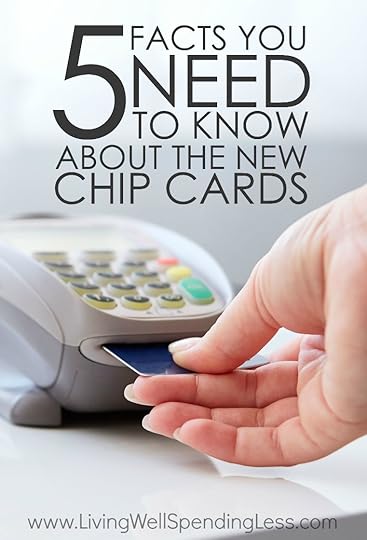
Pin It
The post 5 Facts You Need to Know About the New Chip Cards appeared first on Living Well Spending Less®.
September 28, 2016
Mini Cheesecakes

Mmmmm….cheesecake. I can’t get enough.
But baking one from scratch? No thank you! I’m all about easy, and a complicated cheesecake recipe that requires a special kind of pan is just not in the cards
But luckily I’ve got an awesome alternative that gives me all of the flavor with (almost) none of the effort (or the mess!) These mini cheesecakes not only whip up super fast just six simple ingredients, they only mess up one bowl in the process! (Plus they’re MINI, so that means no calories, right?!)

Here is what you need:
2 8oz. packages cream cheese, softened
3/4 cup sugar
1/2 teaspoon Lemon Vitality™ essential oil or lemon extract
zest of one lemon
2 eggs
1 box Vanilla Wafers
1 can blueberry pie filling

Step 1: Preheat oven to 350 degrees. Then line muffin tin with foil/paper liner. Then place one cookie down in each muffin cup.

Step 3: In large bowl, mix together cream cheese, sugar, eggs, and lemon oil or extract.

Step 4: Spoon cream cheese filling over each cookie.
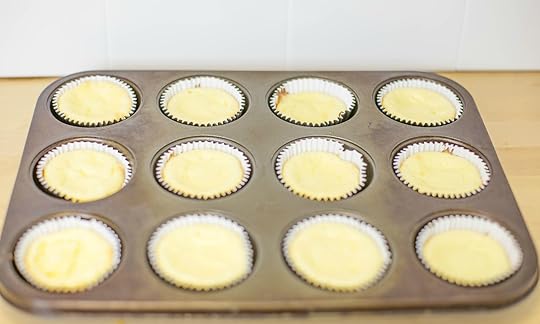
Step 5: Bake for 20 minutes. Then place on rack to cool.

Step 6:Once cool, spoon pie filling on top,then add lemon zest and serve. Store uneaten cheese cakes in fridge.

Print This!
Recipe: Easy Mini Cheesecakes
Summary: These super easy and super cute mini cheesecakes are the perfect sweet treat.
Ingredients
2 8oz. packages cream cheese, softened
1/2 teaspoon Lemon Vitality™ essential oil or lemon extract
zest of one lemon
2 eggs
3/4 cup sugar
1 box Vanilla Wafers
1 can blueberry pie filling
Instructions
Preheat oven to 350 degrees. Then line muffin tin with foil/paper liner. Then place one cookie down in each muffin cup.
In large bowl, mix together cream cheese, sugar, eggs, and lemon oil or extract.
Spoon cream cheese filling over each cookie.
Bake for 20 minutes. Then place on rack to cool.
Once cool, spoon pie filling on top,then add lemon zest and serve. Store uneaten cheese cakes in fridge.
Preparation time: 3-5 minutes
Cooking time: 20 minute(s)
Number of servings (yield): 12-15

Pin It
The post Mini Cheesecakes appeared first on Living Well Spending Less®.
September 26, 2016
What to Do When You Can’t Say No

No. It’s one of the first words we learn.
Have a toddler? Then you’re VERY familiar with the word, as it’s probably come out of your toddler’s mouth–and your own– more than you’d like.
“No, we’re not having cookies for breakfast.”
“No, you can’t cut your hair.”
“No, you can’t play with Mommy’s phone.”
No. No. No.
And yet, when it comes to other people, our ability to simply say no seems to sometimes go right out the window!
Believe me, I get it. I absolutely agonize over saying no. At my core, I want to make people happy and I want to be kind, I want to be helpful and I want to do the right thing. And so I say yes far too often, even when I know I should be saying no.
But a big part of decluttering our minds and getting unstuffed is learning how to clear our calendar of too many obligations and commitments. Because the reality is that in this day and age it is far too easy to fill up our schedules to the brim with things that we don’t really want to do that we’ve said yes to out of obligation and guilt.
And then we end up burned out, frustrated, tired and feeling like the joy has been sucked out of what we’re doing.
Or maybe it’s just me?
I’ve talked to enough fellow moms to know over-commitment is a viral issue. We volunteer as room parents, offer to organize the class party or lead the fall women’s group at church. We say yes to book club and Bunco night, yes to serving snacks at Saturday’s soccer game, yes to helping a friend paint her living room, yes to every minute request our boss asks of us, yes to the neighbor who needs us to watch her cat, yes to playdates and pickups and drop-offs too.
Then there are the times we give in to the yesses from our spouse, our kids and our family members. Our mother calls and needs help over the weekend. Our husband has a work get-together we really don’t want to attend but can’t get out of. Our kids are begging to go here and there and everywhere.
Saying yes too often leads to us spending money we don’t want to spend. It encroaches on our personal time. It eats away at our schedule and takes over our calendar. It leaves us without time to go to the gym, to read a book, or to simply think for five minutes
But where does it end?
Because here’s the thing–although sometimes it might feel selfish to say no in order to carve out more downtime, the alternative–a frazzled and stressed out, overworked and under-appreciated version of ourselves that no one (including ourselves) really likes being around–learning how to say no and eliminate the unessential is one of the kindest, most important things that we can do for the people that we love and the people that matter most.
So how can we handle saying no with grace? It’s not about creating a litany of excuses or subbing in one obligation for another or coming up with white lies and made-up reasons as to why we can’t do something. Instead, it’s about learning how to value our time enough to stand up for it, in a way that preserves both the relationship and our sanity.
Here are a few examples that might help:

The Party Invitation
I love parties, I do. I love the planning and the hosting and the creativity that goes into them. I love playing board games and trying new foods. I even enjoy dressing up when I get the chance. And most of the time, although I tend to be somewhat introverted around people I don’t know, I find social nights with friends and acquaintances fun and engaging. I like the opportunity to catch up and relish the chance to have some grownup conversation.
Sometimes though, an invitation comes up and we’d rather stay home. Maybe it’s been a long week or perhaps we’re just feeling burned out. Or sometimes it’s an invitation for a multilevel marketing get-together—those parties where someone is asking me to try the latest in makeup, cleaning products, cookware, clothing, jewelry or nail designs. And while I love supporting my friends’ business endeavors, the reality is that if I went to every one of those parties, I’d be broke. Sometimes it’s just not in the (credit) cards to attend.
But in these cases, honesty is always the best policy. Instead of making up excuses or lying about a conflicting engagement, simply be up front with your host or hostess, letting them know that you won’t be able to make it. If you’re asked to RSVP, do so right away. Prolonging the inevitable decline just leaves your host hanging and wondering how many to plan for and what the soiree’s going to look like.
A simple “thank you for the invitation, but we can’t make it,” is all you have to say. If you really can’t resist the desire to explain, you can say, “we’ve really been overcommitting ourselves lately and we need some family (or personal) time,” but truthfully, it’s not necessary.
The Repeat Favor
Friends in need shouldn’t be ignored. If you care for someone and they’re really in a pinch, then it’s kind-of your duty to roll up your sleeves and help. After all, that’s what friends do, right? And wouldn’t you want them to do the same for you? Maybe you don’t really WANT to walk your neighbor’s Shih Tzu four times a day while they go to an out-of-town funeral, but someday the roles could be reversed and you’ll feel so relived when they come to your aid.
That said, there are always those friends who need a LOT of favors–the ones who are always asking for something. A ride here and there is one thing, but a ride at 4 AM to the airport when a car service would suffice is quite another. If you feel your kindness is maxed out and you’re feeling stretched a little too thin, it’s time to set some appropriate boundaries.
As uncomfortable as it might seem, honesty is again the best policy. Don’t think of it as letting your friend down, but think of it as prioritizing your needs and the needs of your family. Say something like, “You’re my friend and I love you, and I don’t mind helping out when I can, but lately it has just been a little too much.”
If that feels too harsh or blunt, you could add, “I’m trying to cut back on my obligations because I’ve been feeling overcommitted. I’m sorry, but I can’t help this time.” Letting your friends know when you’re reaching your limit can make the difference between seething with resentment and feeling that happy glow when you’re able to assist a friend in need.
And if you friend gets angry or doesn’t understand? Then she wasn’t that good of a friend to begin with.

The Extended Playdate
Some moms have no problem putting their foot down when it comes to the inevitable, “Can Shelby sleep over? Her mom said yes,” as Shelby looks at you with a hopeful expression. But many moms (and dads!) succumb to the pressure or feel like a bad mom if they don’t give in.
And while kids do need friends and social time, and time to play and have fun, they also need to understand and respect their parents and to know that when you say “no,” it’s okay. If you really don’t want another slumber party, give yourself permission to decline.
I’ve experienced some playdates that turned into free babysitting…for hours and even days. Head it off on the front end by attaching a timeframe to playtime, and eliminating the possibility of the sleepover question from the start. Let kids know friends go home at a set time (such as 5:00pm) and that’s when family time takes place. Have an open conversation with Shelby’s mom as well. Let her know Shelby can come over from 3pm-5pm and she should also give you a heads up if she’s planning to go out or run errands in case something happens during the playdate.
And if the question still comes up? Be ready for it. Simply say “I’m sorry, but not this time. Let me talk to Shelby’s mom to see if we can plan a sleepover on a different night that works for both of us.”
The “Helpful” Advice
In-laws, friends and neighbors can often offer unsolicited advice…and we feel obligated to take it. I know someone who once got the world’s worst haircut–one she didn’t even need–simply because a very assertive friend insisted she use her stylist and hounded her until she called. Yikes.
Usually the unsolicited advice comes from a positive place. Someone is trying to be helpful and kind. They may have experience and wisdom they wish to share, and they may be responding to your uncertainty or insecurity. Maybe they feel by expressing your concerns or complaints, you’re actually seeking their guidance and help.
The first step is to recognize these “helpers” and consciously avoid saying things that may be construed as needy or requests. When someone offers you advice, you can certainly thank them, but set an appropriate distance by saying, “I’ll have to think about that,” or “I’m working on a few ideas right now, but I’ll definitely add your advice to the mix.”
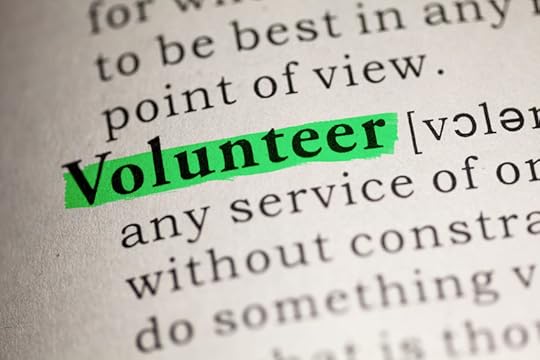
Volunteer Opportunities
Church, school, community events, neighborhood get-togethers, charity work…
While I do strongly believe that these opportunities greatly enhance our lives, and while I am a huge proponent of giving of your time, I also believe that there has to be limits on what we commit ourselves to. Because if we are not careful we can find ourselves secretly resenting the work or losing the spirit of charity by allowing ourselves to be overwhelmed or irritated that it’s encroaching on time with our families and spouse.
It isn’t easy to say no, especially when there are so many great opportunities out there to volunteer and help others out. I know I’ve been in school meetings where there’s call for room moms or help with Teacher Appreciation Week. It’s hard to resist the urge to volunteer, especially when you know the school desperately needs the help and no one else is stepping up.
Say yes to as many things as you can reasonably take on. But if you feel yourself burning out or feeling resentful, it’s time to say no. Pass the opportunity to help on to the next person, and don’t worry, there are plenty of chances to lean in and help out. Another will certainly come along shortly.
If you’re asked to take on something and your schedule (and mental health) just won’t allow, simply say something like, “I’d really love to help out, but right now my schedule just won’t allow it.” If you feel you must, offer an alternative, like, “I can’t take on planning the fundraiser right now, but I’d be happy to help with the Spring Fling,” or “I can’t teach the weekly Sunday school class right now, but please keep me in mind for other opportunities in the future.”
The Guilt Trip
In the same way guilt makes us hold onto items we don’t want or need, guilt can also drive us to take on activities we don’t really want to do.
Now, I realize in life you have to do some things that aren’t so pleasant—trips to the dentist, sweat sessions at the gym, household repairs. I get it. It would be lovely if our days were only filled with fun wonderful things we WANTED to do, but of course they aren’t. Still, there may be things on your schedule you’re doing out of a sense of obligation or because you feel guilty if you don’t. Give yourself permission to tell yourself “no.”
If you don’t really enjoy spin class, it’s okay to quit. If you hold a gym membership but never go, it’s fine to take up walking instead. If you have a garden but absolutely hate weeding and dread “dealing with it,” go to the farmer’s market and fill the bed with grass, mulch or something requiring minimal care.
As women, we often feel we have to cook, clean, sew and take on a whole slew of projects. There’s no set rule about what you have to do. If you don’t really enjoy sewing or scrapbooking, it’s okay to say no. This isn’t the Girl Scouts and there’s no merit badge for “She Who Takes On the Most Projects and Is the Best Homemaker.” If you’re not a big fan of baking, buy your cookies prepackaged and enjoy your talents elsewhere.
Take on projects that bring you joy, fill your life with positivity, or fill the lives with others in positive ways. Give yourself permission to use and say the word “no.” You may find you have more freedom to say “yes” to the things you really want to do!
Share Your Advice: How do you say NO?

Pin It
The post What to Do When You Can’t Say No appeared first on Living Well Spending Less®.

